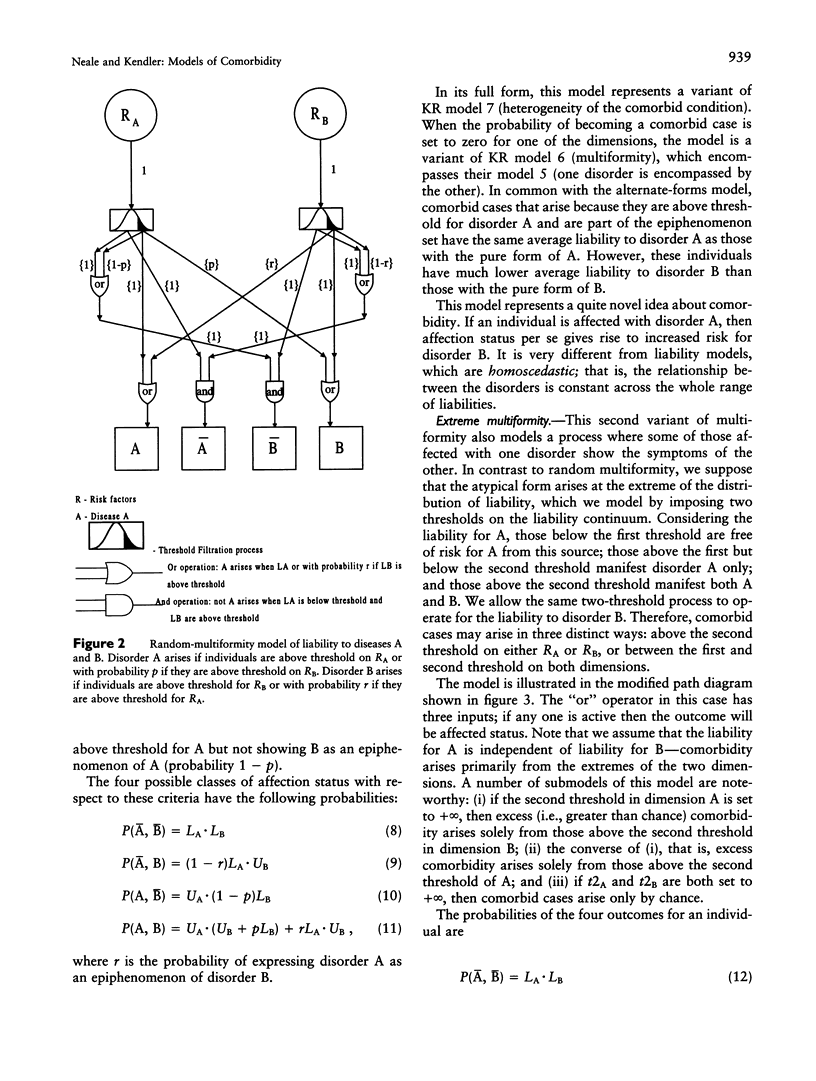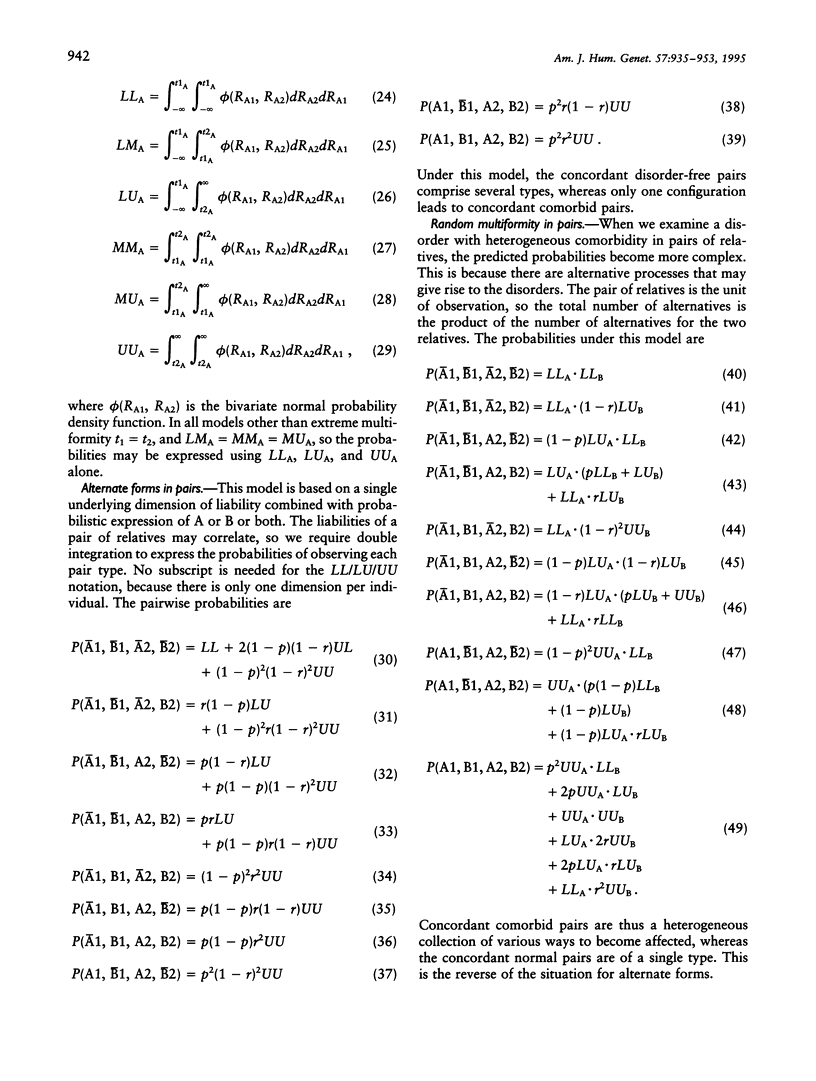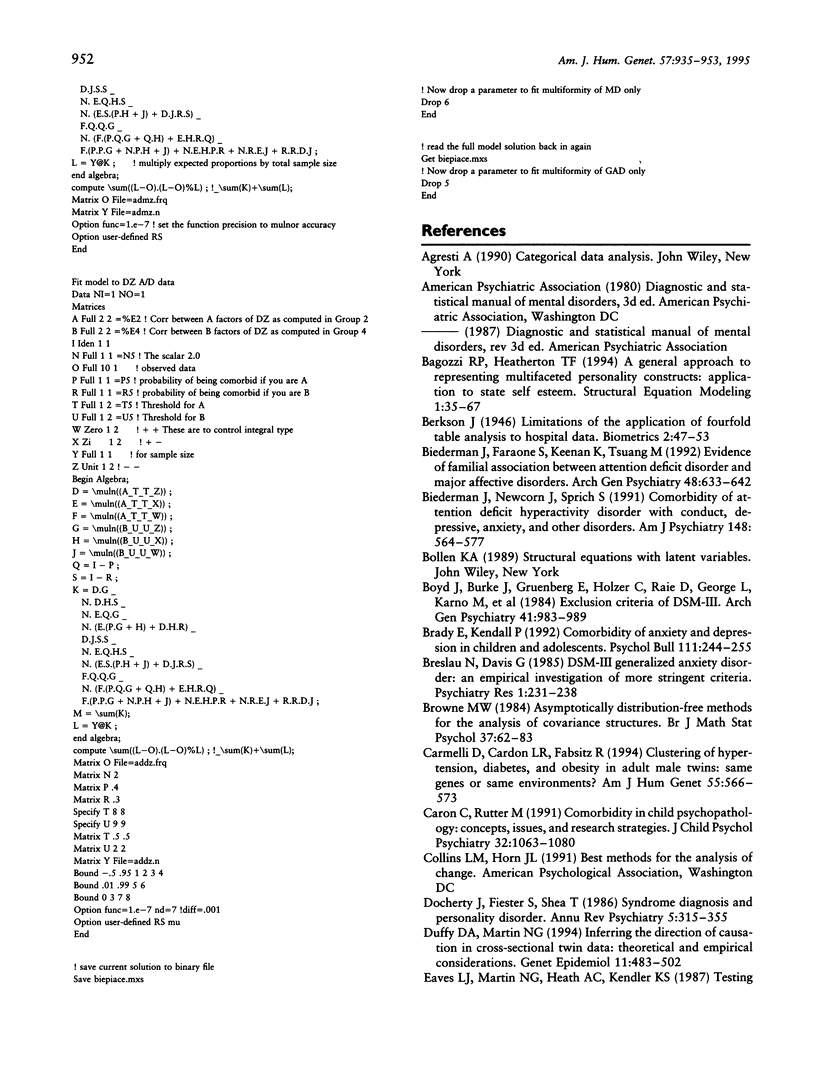Abstract
We develop several formal models for comorbidity between multifactorial disorders. Based on the work of D. N. Klein and L. P. Riso, the models include (i) alternate forms, where the two disorders have the same underlying continuum of liability; (ii) random multiformity, in which affection status on one disorder abruptly increases risk for the second; (iii) extreme multiformity, where only extreme cases have an abruptly increased risk for the second disorder; (iv) three independent disorders, in which excess comorbid cases are due to a separate, third disorder; (v) correlated liabilities, where the risk factors for the two disorders correlate; and (vi) direct causal models, where the liability for one disorder is a cause of the other disorder. These models are used to make quantitative predictions about the relative proportions of pairs of relatives who are classified according to whether each relative has neither disorder, disorder A but not B, disorder B but not A, or both A and B. For illustration, we analyze data on major depression (MD) and generalized anxiety disorder (GAD) assessed in adult female MZ and DZ twins, which enable estimation of the relative impact of genetic and environmental factors. Several models are rejected--that comorbid cases are due to chance; multiformity of GAD; a third independent disorder; and GAD being a cause of MD. Of the models that fit the data, correlated liabilities, MD causes GAD, and reciprocal causation seem best. MD appears to be a source of liability for GAD. Possible extensions to the models are discussed.
Full text
PDF


















Selected References
These references are in PubMed. This may not be the complete list of references from this article.
- Biederman J., Faraone S. V., Keenan K., Tsuang M. T. Evidence of familial association between attention deficit disorder and major affective disorders. Arch Gen Psychiatry. 1991 Jul;48(7):633–642. doi: 10.1001/archpsyc.1991.01810310051009. [DOI] [PubMed] [Google Scholar]
- Biederman J., Newcorn J., Sprich S. Comorbidity of attention deficit hyperactivity disorder with conduct, depressive, anxiety, and other disorders. Am J Psychiatry. 1991 May;148(5):564–577. doi: 10.1176/ajp.148.5.564. [DOI] [PubMed] [Google Scholar]
- Brady E. U., Kendall P. C. Comorbidity of anxiety and depression in children and adolescents. Psychol Bull. 1992 Mar;111(2):244–255. doi: 10.1037/0033-2909.111.2.244. [DOI] [PubMed] [Google Scholar]
- Breslau N., Davis G. C. DSM-III generalized anxiety disorder: an empirical investigation of more stringent criteria. Psychiatry Res. 1985 Jul;15(3):231–238. doi: 10.1016/0165-1781(85)90080-0. [DOI] [PubMed] [Google Scholar]
- Browne M. W. Asymptotically distribution-free methods for the analysis of covariance structures. Br J Math Stat Psychol. 1984 May;37(Pt 1):62–83. doi: 10.1111/j.2044-8317.1984.tb00789.x. [DOI] [PubMed] [Google Scholar]
- Carmelli D., Cardon L. R., Fabsitz R. Clustering of hypertension, diabetes, and obesity in adult male twins: same genes or same environments? Am J Hum Genet. 1994 Sep;55(3):566–573. [PMC free article] [PubMed] [Google Scholar]
- Caron C., Rutter M. Comorbidity in child psychopathology: concepts, issues and research strategies. J Child Psychol Psychiatry. 1991 Nov;32(7):1063–1080. doi: 10.1111/j.1469-7610.1991.tb00350.x. [DOI] [PubMed] [Google Scholar]
- Duffy D. L., Martin N. G. Inferring the direction of causation in cross-sectional twin data: theoretical and empirical considerations. Genet Epidemiol. 1994;11(6):483–502. doi: 10.1002/gepi.1370110606. [DOI] [PubMed] [Google Scholar]
- Eaves L. J., Martin N. G., Heath A. C., Kendler K. S. Testing genetic models for multiple symptoms: an application to the genetic analysis of liability to depression. Behav Genet. 1987 Jul;17(4):331–341. doi: 10.1007/BF01068135. [DOI] [PubMed] [Google Scholar]
- Gunderson J. G., Phillips K. A. A current view of the interface between borderline personality disorder and depression. Am J Psychiatry. 1991 Aug;148(8):967–975. doi: 10.1176/ajp.148.8.967. [DOI] [PubMed] [Google Scholar]
- Heath A. C., Kessler R. C., Neale M. C., Hewitt J. K., Eaves L. J., Kendler K. S. Testing hypotheses about direction of causation using cross-sectional family data. Behav Genet. 1993 Jan;23(1):29–50. doi: 10.1007/BF01067552. [DOI] [PubMed] [Google Scholar]
- Heath A. C., Neale M. C., Hewitt J. K., Eaves L. J., Fulker D. W. Testing structural equation models for twin data using LISREL. Behav Genet. 1989 Jan;19(1):9–35. doi: 10.1007/BF01065881. [DOI] [PubMed] [Google Scholar]
- Jardine R., Martin N. G., Henderson A. S. Genetic covariation between neuroticism and the symptoms of anxiety and depression. Genet Epidemiol. 1984;1(2):89–107. doi: 10.1002/gepi.1370010202. [DOI] [PubMed] [Google Scholar]
- Kendler K. S., Kidd K. K. Recurrence risks in an oligogenic threshold model: the effect of alterations in allele frequency. Ann Hum Genet. 1986 Jan;50(Pt 1):83–91. doi: 10.1111/j.1469-1809.1986.tb01941.x. [DOI] [PubMed] [Google Scholar]
- Kendler K. S., Neale M. C., Kessler R. C., Heath A. C., Eaves L. J. Generalized anxiety disorder in women. A population-based twin study. Arch Gen Psychiatry. 1992 Apr;49(4):267–272. doi: 10.1001/archpsyc.1992.01820040019002. [DOI] [PubMed] [Google Scholar]
- Kendler K. S., Pedersen N. L., Neale M. C., Mathé A. A. A pilot Swedish twin study of affective illness including hospital- and population-ascertained subsamples: results of model fitting. Behav Genet. 1995 May;25(3):217–232. doi: 10.1007/BF02197180. [DOI] [PubMed] [Google Scholar]
- Kendler K. S., Walters E. E., Neale M. C., Kessler R. C., Heath A. C., Eaves L. J. The structure of the genetic and environmental risk factors for six major psychiatric disorders in women. Phobia, generalized anxiety disorder, panic disorder, bulimia, major depression, and alcoholism. Arch Gen Psychiatry. 1995 May;52(5):374–383. doi: 10.1001/archpsyc.1995.03950170048007. [DOI] [PubMed] [Google Scholar]
- Martin N. G., Wilson S. R. Bias in the estimation of heritability from truncated samples of twins. Behav Genet. 1982 Jul;12(4):467–472. doi: 10.1007/BF01065638. [DOI] [PubMed] [Google Scholar]
- Neale M. C., Eaves L. J., Hewitt J. K., MacLean C. J., Meyer J. M., Kendler K. S. Analyzing the relationship between age at onset and risk to relatives. Am J Hum Genet. 1989 Aug;45(2):226–239. [PMC free article] [PubMed] [Google Scholar]
- Neale M. C., Eaves L. J., Kendler K. S. The power of the classical twin study to resolve variation in threshold traits. Behav Genet. 1994 May;24(3):239–258. doi: 10.1007/BF01067191. [DOI] [PubMed] [Google Scholar]
- Neale M. C., Martin N. G. The effects of age, sex, and genotype on self-report drunkenness following a challenge dose of alcohol. Behav Genet. 1989 Jan;19(1):63–78. doi: 10.1007/BF01065884. [DOI] [PubMed] [Google Scholar]
- Neale M. C., Walters E., Health A. C., Kessler R. C., Pérusse D., Eaves L. J., Kendler K. S. Depression and parental bonding: cause, consequence, or genetic covariance? Genet Epidemiol. 1994;11(6):503–522. doi: 10.1002/gepi.1370110607. [DOI] [PubMed] [Google Scholar]


